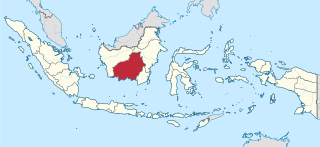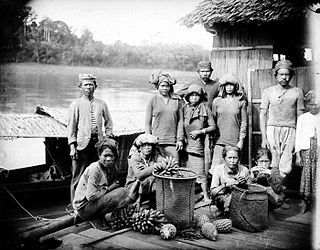
West Kalimantan is a province of Indonesia. It is one of five Indonesian provinces comprising Kalimantan, the Indonesian part of the island of Borneo. Its capital city is Pontianak. The province has an area of 147,307 km2, and had a population of 4,395,983 at the 2010 Census and 5,414,390 at the 2020 Census; the official estimate as at mid 2021 was 5,470,797. Ethnic groups include the Dayak, Malay, Chinese, Javanese, Bugis, and Madurese. The borders of West Kalimantan roughly trace the mountain ranges surrounding the vast watershed of the Kapuas River, which drains most of the province. The province shares land borders with Central Kalimantan to the southeast, East Kalimantan to the east, and the Malaysian territory of Sarawak to the north.

South Kalimantan is a province of Indonesia. It is the smallest province in Kalimantan, the Indonesian territory of Borneo. The provincial capital was Banjarmasin until 15 February 2022 when it was legally moved to Banjarbaru. The population of South Kalimantan was recorded at just over 3.625 million people at the 2010 Census, and at 4.07 million at the 2020 Census. The official estimate as at mid 2021 was 4,112,576. One of the five Indonesian provinces in Kalimantan, it is bordered by the Makassar Strait in the east, Central Kalimantan in the west and north, the Java Sea in the south, and East Kalimantan in the north. The province also includes the island of Laut, located off the eastern coast of Kalimantan. The province is divided into 11 regencies and 2 cities. South Kalimantan is the traditional homeland of the Banjar people, although some parts of East Kalimantan and Central Kalimantan are also included in this criteria. Nevertheless, South Kalimantan, especially the former capital city Banjarmasin has always been the cultural capital of Banjarese culture. Many Banjarese have migrated to other parts of Indonesia, as well as neighbouring countries such as Singapore and Malaysia. In addition, other ethnic groups also inhabit the province, such as several groups of the Dayaks, who mostly live in the interior part of the province, as well as the Javanese, who mostly migrated from Java due to the Transmigration program which dated from the Dutch colonial era.

Central Kalimantan is a province of Indonesia. It is one of five provinces in Kalimantan, the Indonesian part of Borneo. Its provincial capital is Palangka Raya and in 2010 its population was over 2.2 million, while the 2015 Intermediate Census showed a rise to 2.49 million and the 2020 Census showed a total of 2.67 million; the official estimate as at mid 2021 was 2,702,200.

Banjarmasin is a city in South Kalimantan, Indonesia. It was the capital of the province until 15 February 2022. The city is located on a delta island near the junction of the Barito and Martapura rivers. Historically the centre of the Banjarese culture, and the capital of the Sultanate of Banjar, it is the biggest city in South Kalimantan and one of the main cities of Kalimantan. The city covers an area of 98.46 km2 (38.02 sq mi) and had a population of 625,481 as of the 2010 Census and 657,663 as of the 2020 Census; the official estimate as of mid 2021 was 662,320. Greater Banjarmasin, also known as Banjarbakula, is an urban agglomeration of around two million people covering an area of 8,136 km2 (3,141 sq mi), which includes Banjarbaru city and parts of Banjar Regency, Barito Kuala Regency, and Tanah Laut Regency, and accounts for almost half of the province's population. It is the third most populous city on the island of Borneo.
The Sula Islands Regency is one of the regencies in North Maluku province of Indonesia. It was originally formed on 25 February 2003, when it encompassed the three large islands comprising the Sula Archipelago, together with minor adjacent islands. However, the largest and most westerly of the three, Taliabu, was split off from the Sula Islands Regency on 14 December 2012 to form a separate regency.

The Barito River is the second longest river in Borneo after the Kapuas River with a total length of 1,090 km (680 mi) and with a drainage basin of 81,675 square kilometers (31,535 sq mi) in South Kalimantan, Indonesia. It originates in the Muller Mountain Range, from where it flows southward into the Java Sea. Its most important affluent is the Martapura River, and it passes through the city of Banjarmasin.

Barito Kuala Regency is one of the regencies (kabupaten) in the Indonesian province of South Kalimantan. The area is 2,996.46 km2, and the population was 276,147 at the 2010 Census and 313,021 at the 2020 Census; the latest official estimate was 316,963. The capital is the town of Marabahan. The Motto of the Regency is "Selidah".

Bakumpai or Baraki are indigenous people of Borneo and are considered as a sub-ethnic group of the Dayak Ngaju people group with Islamic background. The Bakumpai people first occupy along the Barito riverbanks in South Kalimantan and Central Kalimantan, from Marabahan to Puruk Cahu, Murung Raya Regency. The Bakumpai people first appeared as a newly recognized people group in census 2000 and were made up of 7.51% of Central Kalimantan population, which before this the Bakumpai people were considered as part of the Dayak people in a 1930 census.

The Kapuas River is a river in the Indonesian part of Borneo island. It originates in the Müller Mountain Range at the center of the island and flows south until merging with the Barito River and discharging into the Java Sea. It should be distinguished from another Kapuas River, which starts on the other side of the same mountain range in central Borneo, but flows to the west and empties to the South China Sea.
The Negara River is a river of Borneo, Indonesia. It flows in the southeast region of the island, within the Negara District, province of South Kalimantan. It is the second longest river in the province after the Barito River, which the Negara River flows into.

South Barito Regency is a regency in Central Kalimantan province of Indonesia. The regency seat is located in town of Buntok, located in South Dusun district. The population of South Barito Regency was 124,128 at the 2010 Census and 131,100 at the 2020 Census; the official estimate as at mid 2021 was 131,606.

North Barito Regency is one of the thirteen regencies which divide the Central Kalimantan Province on the island of Kalimantan, Indonesia. Muara Teweh is the capital of North Barito Regency, which covers an area of 8,300 km2. The population of North Barito Regency was 121,573 at the 2010 Census and 154,812 at the 2020 Census; the official estimate as at mid 2021 was 157,231.

Kapuas Regency is one of the thirteen regencies which divide Central Kalimantan Province, on the island of Kalimantan, Indonesia. It formerly covered a wider area, but on 10 April 2002 two further regencies were cut out of its western districts, and the residual area is now 14,999 km.2 Its population was 329,646 at the 2010 Census and 410,400 at the 2020 Census; the official estimate as at mid 2021 was 416,181. The administrative centre is the town of Kuala Kapuas near the coast, but the largest town is Selat, which includes 8 of the regency's 15 urban kelurahan.

Seruyan Regency is one of the thirteen regencies which comprise the Central Kalimantan Province on the island of Kalimantan (Borneo), Indonesia. The town of Kuala Pembuang in Seruyan Hilir District is the capital of Seruyan Regency. The population of the Regency was 139,931 at the 2010 Census and 162,906 at the 2020 census; the official estimate was at mid 2021 was 164,378.
The Trans-Kalimantan Highway Southern Route, or simply the Trans-Kalimantan Highway, is a 3,901-kilometre (2,424 mi) national road that forms the backbone highway system in Kalimantan, Indonesia. It forms a part of the larger Pan-Borneo Highway network which also combines with highway networks of East Malaysia and Brunei. The combined highway network forms the entire Asian Highway Network Route AH150.
This is a list of emblems or coat of arms used in Indonesia. Indonesia is divided into 38 provinces, and each province is divided into regencies (kabupaten) and cities (kota). There are 416 regencies and 98 cities. Each province, regency, and city has its own emblem.

BRT Banjarbakula, also informally known as "Tayo bus", is a bus rapid transit (BRT) system serving Greater Banjarmasin metropolitan area, encompassing Banjarmasin, Banjarbaru, and parts of Banjar Regency in Indonesia. It comprises three routes and more than 37 bus stops as of 2019. After several months of trials with free service, it launched on 14 August 2019 to coincide with the celebration of 69 years since the creation of South Kalimantan province. The local government plans to expand the system to 6 routes and a total of 112 bus stops, encompassing the entire Banjar regency, Tanah Laut regency, and Barito Kuala regency; covering the entire metropolitan area with service. The government is also considering handing operations to a private firm in 2021 to boost its development. As of September 2020, recruitment of new drivers for the service was stalled because of the COVID-19 pandemic, hampering route and fleet expansion needed to keep up with demand.

Tamiang Layang, a sub-district in the district of Dusun Timur, is the regency seat of East Barito Regency and also one of the towns in Central Kalimantan. This town is at a distance of 287 km east of Palangka Raya city, the capital of Central Kalimantan Province. The population of this town is roughly 10,780 people as of 2021.
















